#the urusei yatsura reference was unexpected
Explore tagged Tumblr posts
Photo
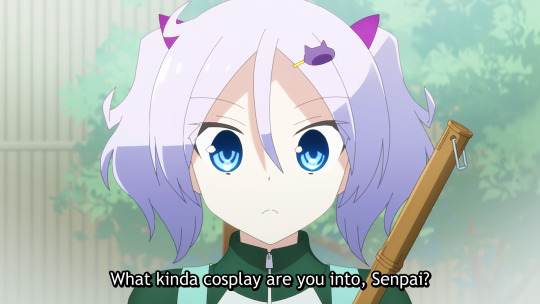



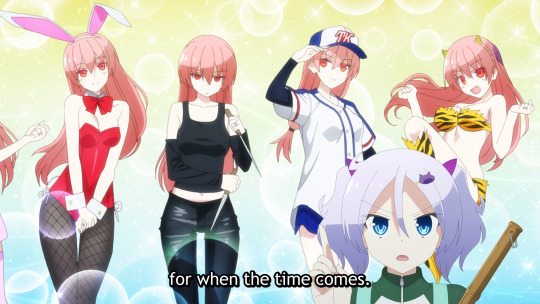
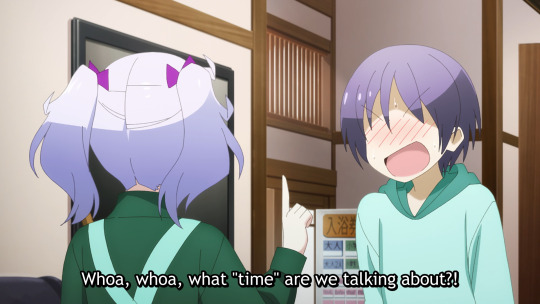
Whoa, whoa, what “time” are we talking about?!
95 notes
·
View notes
Text
Spooky Month Before Christmas Commissions~
Protocultural Pondering

Commissioned by @michaelmac6072
The Space Emigration fleet in its intergalactic crossroads, are met by the retrofit Zentradi cruiser TALOS, in order to carry out a special assignment of great importance, one that requires a radical step in regards to diplomatic interactions with the inhabitants of the Oceanus drift.
The duet of captains behind the command of the Talos; Moroboshi and Oniboshi, they're no strangers when it comes to collaborating alongside their Terran and Zentran allies, their whole ship is a testimony to the phrase "mixed-up", much like most of the crews and fleets that were raised from the ashes of the great space war back on Earth. But amidst their interstellar exploits, the crew of the Talos have always pondered if the Zentradi's coveted bioengineering devices, could work for humans too, based on solid evidence regarding the genetics of humanity and Zentradi alike.
2/?? commissioned art
Today..
it was finally proven by Captain Misa Hayase herself, that there wasn't a large difference as the crew first thought, even when questioned whether there were unexpected side effects or factors into play that could place a strain on the human physiology, the impossible became possible...
With this action....it reinforces the relationship between these two civilizations...regardless of their origins, their differences, the events of the past and those to come, Zentradi and Human..are forever one..and in the right path..they can bring peace once again to the milky way.
=POST DATA=
• the captains of the Talos are essentially cameos of the main characters of Rumiko Takahashi's Urusei Yatsura, and if you know the history behind the creation of Macross during it's early stages...I bet you can understand the deep cut reference behind their inclusion, if not, TLDR, Urusei Yatsura influenced the shift for what was originally called Battle City Megaroad into Macross as we knew it, either in its original form or it's Robotech counterpart.
•Misa Hayase's uniform: without going into too much detail, let's just say that this is a sneak peak of sorts into something I'm working on in the future.
#artists on tumblr#commissioned art#commission art#fanart#gentle giant#giant and tiny#gianttiny#gt/tiny#giantess#gentle giantess#super dimension fortress macross#misa hayase
54 notes
·
View notes
Text
Animation Night 115: Early Mamoru Oshii
Hi friends! It’s Thursday, the sun is no longer trying to kill me, let’s enjoy some animated films!
So, Mamoru Oshii! Know him, maybe love him - he’s the guy who makes slooooow-paced serious philosophical anime films in near future sci-fi settings, and he hangs out with the best realist animators at Headgear/Production I.G. right? But what was he before he was that?
Funnily enough, our boy Oshii made the first OVA. Not, mind you, the first successful OVA - that honour goes to Megazone 23, which we watched on Animation Night 103. (There is much more to say about the later episodes of Megazone 23, with the second especially being an interesting unsuccessful experiment in what would become the ‘realist’ style, but I’ll save that for the day we cover Yasuomi Umetsu.)
So, if Oshii got in there first, what was his contribution? That is Dallos - but I’m getting ahead of myself~
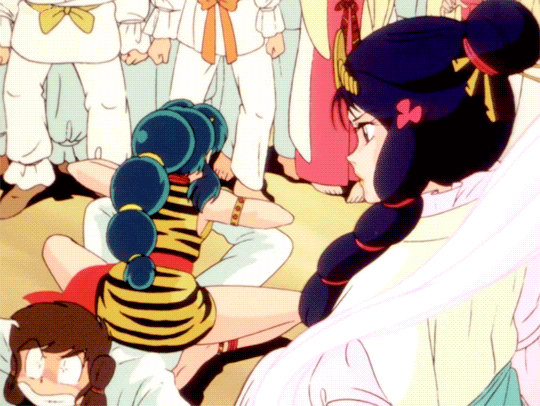
...because to begin, before he was the Ghost in the Shell guy, indeed before he was Patlabor guy, Mamoru Oshii was the Urusei Yatsura guy!
So, Urusei Yatsura. This is one of those big classics. It began as a Weekly Shōnen Sunday manga running from '78 to ‘87 by Rumiko Takahashi, also known for other household-name classics like Ranma 1/2 and Inuyusha. The series is, so far as I understand, mostly light-hearted comedy about the lives of a horny boy and a hornéd alien who get married for kind of silly reasons.
So, the anime! Our boy Oshii entered the anime industry shortly after graduation in 1977, at Tatsunoko Productions, a studio with a lot of history that you can go read (drink) Matteo Watzky write about with a lot of interesting detail! In 1980, he jumped ship to Pierrot. I’m not sure Rumiko Takahashi was quite such a big name then as she is now... whatever the reason, this relatively untested young director got put in charge of the show, and absolutely killed it...
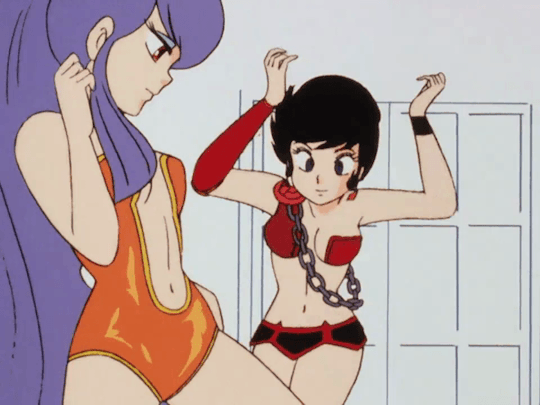
Here is how Watzky introduces Urusei Yatsura...
Urusei Yatsura is probably one of the defining works of anime history at large, a central piece of otaku history, and the show that truly launched many of the stylistic and visual trends we still associate with “80s anime”. Its format—a long-running comedy series—placed it in the lineage of the great absurd A Pro comedies of the 70’s like Dokonjo Gaeru or Ganso Tensai Bakabon, and their descendants such as Doraemon. However, Urusei Yatsura differed from these on at least three points: its SF setting, its romantic comedy genre, and its parodic aspect. These were all the elements needed to cater to the burgeoning population of otaku and their sensibility for cool mecha, cute girls, and pop culture references.
In terms of production, the series was the directorial debut of yet another young visionary: thirty-year-old Mamoru Oshii. Despite many conflicts with the mangaka Rumiko Takahashi, he led the show in unexpected and experimental directions, and played a large part in giving the young Kanada-style animators a place to completely and freely express themselves, thereby largely contributing to the stylistic revolution that would take anime by storm. Along with him, the other major members of the staff who initially worked with the Kanada school were episode director Keiji Hayakawa and animation director Asami Endô.
Of course, a director alone very much doesn’t make a TV show. And what made Urusei Yatsura so successful was being, essentially, the flagship of Kanada-school animation, as (once again) Watzky documents here. In particular, Watzky’s article discusses two of Kanada’s protégés who worked with him at Studio Z2/Z3, Masahito Yamashita and Shinsaku Kōzuma.
To summarise, Yamashita excelled at effects animation, developing Kanada’s characteristic ‘liquid fire’ in a more angular, contrasting direction over the course of the 1980 version of Tetsujin 28-go (for example). And Kōzuma was following Kanada’s clever use of a highly varied framerate in character animation to help the extreme poses pop, as well as developing his own style of explosions (kind of a theme, here!)

Oshii was wise enough to recognise the potential in the wild, off-model Kanada school antics, and Yamashita and Kōzuma increasingly became prominent across the show’s run. Just as important was his fellow Tatsukonoko alumnus Motosuke Takahashi, once called “Pierrot’s trump card” by the director, whose loose, extremely clear style of character animation earned praise from Miyazaki as well; like the Kanada school animators he enjoyed tricks like background animation, but tended to prefer a steady, fluid approach with a more even framerate - though in an interesting cross-section of artistic development, his style gradually drifted towards his Kanada-school peers over the show’s run.
And so many others who worked on Urusei Yatsura would go on to make other significant works in the 80s: Katsuhiko Nishijima, director of Project A-ko, and prolific character designer Toshiki Hirano, who I gave an entire Animation Night a couple months ago.
The problem with something of the sheer scale of Urusei Yatsura, though, is that there’s far too much to cram into one Animation Night. So, rather arbitrarily, I’m going to pull out the first of the movies that spun off from the TV show, Only You, directed by Oshii in 1983. And this film is apparently the favourite of Rumiko Takahashi herself, the one she considers truest to the manga, so that’s a nice extra. But to set context, I’ll also try and squeeze in a little of the TV show...

Now then, what of Dallos? After a couple of years of redefining anime with Urusei Yatsura, Studio Pierrot must have been feeling pretty confident, and decided to go for a sci-fi series to compete with the mighty Gundam. However, the funders Bandai decided it wouldn’t sell many toys with it and so shut down the project with just four episodes. This meant the scale of it was in an awkward place between a feature film and a TV series, so Bandai, or Pierrot (my sources are a little contradictory here and I don’t have time to dig in to which is right!) decided to try out going direct to this exciting new “home video” market that was suddenly all the rage in Japan.
The writer-director team consisted of Oshii and his mentor Hisayaki Toriumi, also of Tatsunoko, known for works like Science Ninja Team Gatchaman and (notable to me if only because its OP is a total earworm) Japanese-French collab The Mysterious Cities of Gold. The film is set on a moon colony which stages a rebellion, and the film takes inspiration from live action works like The Battle of Algiers (1966) (surprisingly relevant to last week!), by way of Heinlein. The rebels are in a hopeless situation, outside a mysterious artefact ‘Dallas’ of unknown powers.
The lack of a need to flog toys allows the story to go somewhere a bit more complex than other mecha anime of the time, and this is apparently the main strength of the project. Despite the grand geopolitical backdrop, it’s a relatively small scale and bleak story of people caught up in the conflict. It sounds honestly very compelling.
There’s some neat touches in the animation, like its portrayal of zero-gravity, and a level of violence that wouldn’t pass on TV, and some truly impressive moments where Yamashita gets to flex his talents at mecha and effects. Unfortunately I don’t have any sort of detailed history of the animation to hand, beyond that it seems to mostly share the same crew as Urusei Yatsura.
Oshii’s direction style isn’t yet in full effect, although you can apparently already see hints of it in moments like the aftermath of a battle. But this would probably be the first time he could indulge in the kind of sci-fi mecha story he would end up spending his whole career on, so it should be really interesting to see.
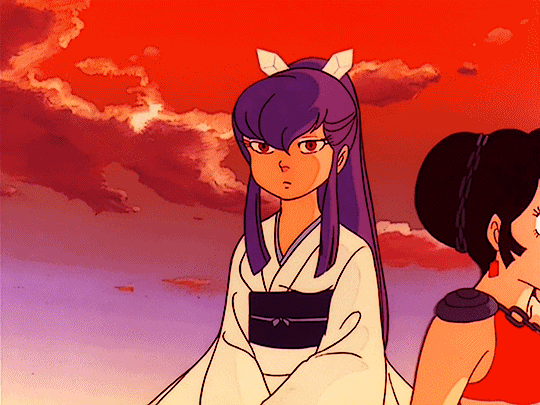
So, without further ado, let’s begin Animation Night 115! And hopefully soon I can show you more of Urusei Yatsura, once I think of a good way to organise it~
Animation Night 115 will be going live now at picarto.tv/canmom! Films will be starting in about 30 minutes most likely, see you there!
5 notes
·
View notes